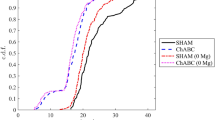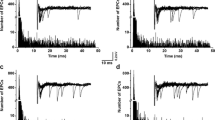Abstract
Recently, we demonstrated the existence of nonextensive behavior in neuromuscular transmission (da Silva et al. in Phys Rev E 84:041925, 2011). In this letter, we first obtain a maximum-likelihood q-estimator to calculate the scale factor (\(\alpha \)) and the q-index of q-Gaussian distributions. Next, we use the indexes to analyze spontaneous miniature end plate potentials in electrophysiological recordings from neuromuscular junctions. These calculations were performed assuming both normal and high extracellular potassium concentrations \([K^{+}]_{o}\). This protocol was used to test the validity of Tsallis statistics under electrophysiological conditions closely resembling physiological stimuli. The analysis shows that q-indexes are distinct depending on the extracellular potassium concentration. Our letter provides a general way to obtain the best estimate of parameters from a q-Gaussian distribution function. It also expands the validity of Tsallis statistics in realistic physiological stimulus conditions. In addition, we discuss the physical and physiological implications of these findings.




Similar content being viewed by others
References
Adrian RH (1956) The effect of internal and external potassium concentration on the membrane potential of frog muscle. J Physiol (Lond) 133:631
Bakar B, Tirnakli U (2009) Analysis of self-organized criticality in Ehrenfestś dog-flea model. Phys Rev E 79(040):103
Banker BQ, Kelly SS, Robbins N (1983) Neuromuscular transmission and correlative morphology in young and old mice. J Physiol (Lond) 339:355–377
Bennett MR, Robinson J (1990) Probabilistic secretion of quanta from nerve terminals at synaptic sites on muscle cells: non-uniformity, autoinhibition and the binomial hypothesis. Proc R Soc Lond B 239:329–358
Bercher JF (2012) On generalized Cramer–Rao inequalities, generalized fisher information and characterizations of generalized q-Gaussian distributions. J Phys A 45(255):303
Borges EP (1998) On a q-generalization of circular and hyperbolic functions. J Phys A Math Gen 31:5281
Borges EP (2004) A possible deformed algebra and calculus inspired in nonextensive thermostatistics. Phys A 340:95–101
Burnecki K, Wylomanska A, Beletskii A, Chechkin VGA (2012) Recognition of stable distribution with Levy index \(\alpha \) close to 2. Phys Rev E 85(056):711
Bustamente CD, Nielsen R, Hartl DL (2003) Maximum likelihood and bayesian methods for estimating the distribution of selective effects among classes of mutations using DNA polymorphism data. Theor Popul Biol 63:91–103
Capurro A, Diambra L, Lorenzo D, Macadar O, Martin MT, Mostaccio C, Plastinob A, Perez J, Rofman E, Torres ME, Velluti J (1999) Human brain dynamics: the analysis of EEG signals with Tsallis information measure. Phys A 265:235–254
Carlson CG, Kriebel ME, Muniak CG (1982) The effect of temperature on the amplitude distributions of miniature endplate potentials in the mouse diaphragm. Neuroscience 07:2537–2549
Castellucci VF, Kandel E (1974) A quantal analysis of the synaptic depression underlying habituation of the gill-withdrawal reflex in aplysia. Proc Nat Acad Sci 71:5004–5008
Ceccarelli B, Grohovaz F, Hurlbut WP (1979) Freeze-fracture studies of frog neuromuscular junctions during intense release of neurotransmitter. J Cell Biol 81:178–192
Cooper RL, Stewart BA, Wojtowicz JM, Wang S, Atwood HL (1995) Quantal measurement and analysis methods compared for crayfish and drosophila neuromuscular junctions, and rat hippocampus. J Neurosci Methods 61:67–78
da Silva AJ, Lima RF, Moret MA (2011) Nonextensivity and self-affinity in the mammalian neuromuscular junction. Phys Rev E 84:041925
del Castillo J, Katz B (1954) Quantal components of the end-plate potential. J Physiol (Lond) 124:560–573
der Kloot WV (1991) The regulation of quantal size. Prog Neurobiol 36:93–130
der Kloot WV, Cohen I (1984) Temperature effects on spontaneous and evoked quantal size at the frog neuromuscular junction. J Neurosci 04:2200–2203
der Kloot WV, Andricioaeia I, Balezina OP (1999) Examining the timing of miniature endplate potential releases at the frog and mouse neuromuscular junctions for deviations from poisson expectations. Pflug Arch Eur J Physiol 438:578–586
Douglas P, Bergamini S, Renzoni F (2006) Tunable tsallis distributions in dissipative optical lattices. Phys Rev Let 96(110):601
Fatt P, Katz B (1952) Spontaneous subthreshold activity at motor nerve endings. J Physiol (Lond) 117:109–128
Ferrari D, Yang Y (2010) Maximum lq-likelihood estimation. Ann Stat 38:753–783
Glavinovic MI (1988) Changes in miniature end-plate currents due to high potassium and calcium at the frog neuromuscular junction. Synapse 2:636–658
Grohovaz F, Fesce R, Haimann C (1989) Dual effect of potassium on transmitter exocytosis. Cell Biol Int 13:1085–95
Harlow ML, Stoschek DRA, Marshall RM, McMahan UJ (2001) The architecture of active zone material at the frog’s neuromuscular junction. Nature (London) 409:479–484
Hasegawa Y, Arita M (2009) Properties of the maximum q-likelihood estimator for independent random variables. Phys A 388:3399–3412
Hughes BW, Kusner LL, Kaminski H (2006) Short-term and long-term plasticity and physiological differentiation of crustacean motor synapses. Muscle Nerve 33:445–461
Kleinhans D (2012) Estimation of drift and diffusion functions from time series data: a maximum likelihood framework. Phys Rev E 85(026):705
Lima RF, Prado VF, Prado MAM, Kushmerick C (2010) Quantal release of acetylcholine in mice with reduced levels of the vesicular acetylcholine transporter. J Neurochem 113:943–951
Lovsletten O, Rypdal M (2012) Approximated maximum likelihood estimation in multifractal random walks. Phys Rev E 85(046):705
Lowen SB, Cash SS, Poo MM, Teich MC (1997) Quantal neurotransmitter secretion rate exhibits fractal behavior. J Neurosci 17:5666–5677
Lupa M T (1987) Calcium-insensitive miniature endplate potentials at the neuromuscular junction. Synapse 1:281–292
Martin AR (1955) A further study of the statistical composition of the end-plate potential. J Physiol 130:114–122
McLachlan EM, Martin AR (1981) Non-linear summation of end-plate potentials in the frog and mouse. J Physiol 311:307–324
Nishimura M, Shimizu Y, Satoh E, Yokoyama T, Yagasaki O (1993) Factors influencing the twin-pulse facilitation of the release of transmitter at the mouse neuromuscular junction. Gen Pharmacol 24:1241–1247
Ostby I, Oyehaug L, Einevoll G, Nagelhus E, Plahte E, Zeuthen T, Lloyd C, Ottersen O, Omholt S (2009) Astrocytic mechanisms explaining neural-activity-induced shrinkage of extraneuronal space. PLOS Comput Biol 5:1–12
Parsons RL, Hofmann WW, Feigen GA (1965) Presynaptic effects of potassium ion on the mammalian neuromuscular junction. Nature (London) 208:590–591
Sakaba T, Schneggenburger R, Neher E (2002) Estimation of quantal parameters at the calyx of Held synapse. Neurosci Res 44:343–356
Schneggenburger R, Sakaba T, Neher E (2002) Vesicle pools and short-term synaptic depression: lessons from a large synapse. Trends Neurosci 25:206–212
Shalizi CR (2007) Maximum likelihood estimation for q-exponential (Tsallis) distributions. e-print arXiv:math/0701854v2
Slater CR (2008) Structural factors influencing the efficacy of neuromuscular transmission. Ann NY Acad Sci 1132:1–12
Smith BR, Wojtowicz JM, Atwood HL (1991) Maximum likelihood estimation of non-uniform transmitter release probabilities at the crayfish neuromuscular junction. J Theor Biol 150:457–472
Suyari U, Tsukada M (2005) Law of error in Tsallis statistics. IEEE Trans Inf Theory 51:753–757
Syková E, Nicholson C (2008) Diffusion in brain extracellular space. Physiol Rev 88:1277–1340
Takeda T, Sakata A, Matsuoka T (1999) Fractal dimensions in the occurrence of miniature end-plate potential in a vertebrate neuromuscular junction. Prog Neuro-Psychopharmacol Biol Psychiatry 23:1157–1169
Takeuchi A, Takeuchi N (1961) Changes in potassium concentration around motor nerve terminals, produced by current flow, and their effects on neuromuscular transmission. J Physiol (London) 155:46–58
Tremblay JP, Robitaille R, Grenon G (1984) Distribution of spontaneous release along the frog neuromuscular junction. Neurosci Lett 51:247–252
Triller A, Korn H (1982) Transmission at a central inhibitory synapse. III. Ultrastructure of physiologically identified and stained terminals. J Neurophysiol 48:708–736
Tsallis C (2009) Introduction to nonextensive statistical mechanics: approaching a complex world. Springer, Berlin
Washio HM, Inouye ST (1980) The statistical analysis of spontaneous transmitter release at individual junctions on cockroach muscle. J Exp Biol 87:195–201
Wernig A (1975) Estimates of statistical release parameters from crayfish and frog neuromuscular junctions. J Physiol (London) 244:207–221
Worden MK, Bykhovskaia M, Hackett JT (1997) Facilitation at the lobster neuromuscular junction: a stimulus-dependent mobilization model. J Neurophysiol 78:417–428
Yeghiazarian L, Kaiser M (1998) Role of temperature in quanta mechanisms of facilitation in the frog neuromuscular junction. Biol Cybern 79:59–66
Zhang D, Jia X, Ding H, Ye D, Thakor NV (2010) Application of Tsallis entropy to EEG: quantifying the presence of burst suppression after asphyxial cardiac arrest in rats. IEEE Trans Biomed Eng 57:867–874
Acknowledgments
This work was supported in part by Conselho Nacional de Desenvolvimento Científico e Tecnológico (CNPQ). The authors would like to thank Constantino Tsallis for his valuable comments and Christopher Kushmerick for his support.
Author information
Authors and Affiliations
Corresponding author
Rights and permissions
About this article
Cite this article
da Silva, A.J., Trindade, M.A.S., Santos, D.O.C. et al. Maximum-likelihood q-estimator uncovers the role of potassium at neuromuscular junctions. Biol Cybern 110, 31–40 (2016). https://doi.org/10.1007/s00422-015-0673-3
Received:
Accepted:
Published:
Issue Date:
DOI: https://doi.org/10.1007/s00422-015-0673-3




